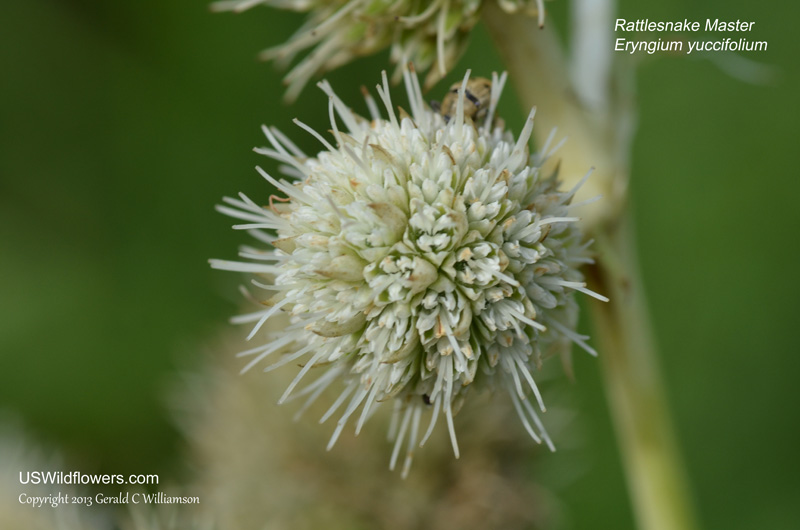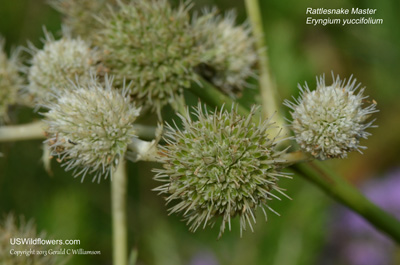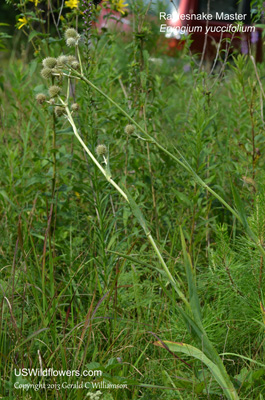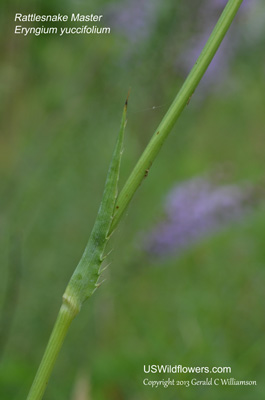Rattlesnake Master, Button Eryngo, Button Snakeroot, Yuccaleaf Eryngo - Eryngium yuccifolium
|
Eryngium yuccifolium - Rattlesnake Master, Button Eryngo, Button Snakeroot, Yuccaleaf Eryngo. There are about 250 species of Eryngium in the world, with about 35 in the United States. While most are native to the U.S., several are introduced. It appears that all Eryngium found in the wild in Canada are introduced. While more Eryngium species are found in the western half of the country, the eastern Eryngium yuccifolium is the most widely distributed species of the genus in the United States (it is not found in Canada.)
As with many plants, Eryngium yuccifolium was used (and may continue to be used) by native Americans for medicinal purposes, with the roots being used to relieve toothaches and as a remedy for bladder and kidney problems, and as indicated by one of its common names, as a treatment for snakebite, especially that of the rattlesnake.
Found in:
AL, AR, CT, FL, GA, IA, IL, IN, KS, KY, LA, MD, MI, MN, MO, MS, NC, NE, NJ, OH, OK, SC, TN, TX, VA, WI
Leave comments on Eryngium yuccifolium at this link. | 
Distribution of Eryngium yuccifolium in the United States and Canada:

Map courtesy of The Biota of North America Program.
Map color key
Search Our Database: Enter any portion of the Scientific, Common Name, or both.
Do a general Google search of the entire site:
#ad
 Follow USWildflowers on Twitter
| | Site: Ascalon Road, Walker County, GA Date: 2013-August-04 | Photographer: Gerald C Williamson
Nikon D7000 | | While not clearly visible from this photo, the flower heads are subtended by several sharp, spreading bracts that give the inflorescence a spiny appearance. | | 
| | Site: Ascalon Road, Walker County, GA Date: 2013-August-04 | Photographer: Gerald C. Williamson
Nikon D7000
Tamron SP 90MM f/2.8 AF Macro | | Each flower head is spherical and made up of many green to greenish-white flowers. The heads are held on stout peduncles at the end of the stems. | | Click on the photo for a larger image

| | Site: Ascalon Road, Walker County, GA Date: 2013-August-04 | Photographer: Gerald C Williamson
Nikon D7000 | | The species name "yuccifolium" refers to the long, yucca-like leaves, most of which are basal or near the bottom of the stem. These basal and lower cauline leaves can be up to 3 feet long. Unbranched (up to the inflorescence) stems arise from the root stock. The cauline leaves are much shorter than the basal leaves. | | Click on the photo for a larger image

| | Site: Ascalon Road, Walker County, GA Date: 2013-August-04 | Photographer: Gerald C Williamson
Nikon D7000 | | he upper cauline leaves of Eryngium yuccifolium are much shorter than the basal leaves. All cauline leaves clasp the stem, a noteworthy diagnostic for this species. All the leaves have parallel veins, which helps to differentiate it from E. aquaticum, which has more pinnate veins. Another diagnostic for these two similar species is that Eryngium yuccifolium always has spines on the leaf margins, while E. aquaticum may not have the spines. Eryngium yuccifolium var. yuccifolium has single spines, while the spines of var. synchaetum spines are in bundles (fascicles) of 1-4 spines. | | Click on the photo for a larger image

|
References used for identification and information:
|
|
| |
| #ad
|
|






